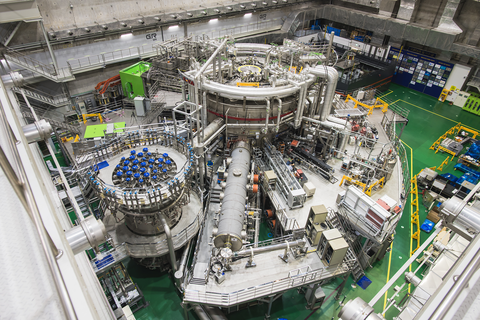Korean Fusion Reactor Hits Temps 7 Times Hotter Than the Sun
Korea Institute of Fusion Energy
- South Korea’s KSTAR reactor reached and held a temperature of 100 million degrees Celsius for a full 30 seconds.
- This achievement highlights that nuclear fusion is somewhat at odds with its hardware.
- KSTAR is an important feeder project for ITER in France, making this record even more important.
South Korea’s national nuclear fusion research facility has reached an important milestone with its tokamak reactor: holding a temperature above 100 million degrees Celsius for 30 seconds.
The Korea Superconducting Tokamak Advanced Research center (KSTAR) is an established tokamak that has been chipping away at its milestone goals since 2008. It’s also a key part of the developmental pipeline that is currently ramping up to the massive International Thermonuclear Experimental Reactor project, or ITERS. So yes, every milestone is doubly important in the global push toward nuclear fusion energy. But does that mean we’re really any closer?
⚡️ Science explains the world around us. We’ll help you make sense of it all—join Pop Mech Pro.
Nuclear energy is an umbrella term referring to technologies that manipulate the nucleuses of atoms in order to generate heat that turns into electrical energy. The nuclear plants in play today use fission technology, meaning the use of heavier elements whose nucleuses are forcibly split in order to release heat energy. Proponents say the next big thing in nuclear energy is fusion—when extremely light elements have additional particles forcibly added, or fused with, their nucleuses. There are great advantages to this, but also very high costs because fusion reactions require temperatures many, many times higher.
KSTAR’s new record performance, while exciting, highlights a dichotomy that runs through the entire nuclear fusion energy industry. That’s because our physical assemblies to support “artificial suns” like KSTAR are still made of regular, Earth-bound materials. Think about how you would design some kind of scaffolding to “contain” the sun; how could you do that without everything immediately melting? Even the extremely far-future idea of the Dyson sphere relies on an empty buffer between the star and the plates that collect its energy.
Inside a typical tokamak reactor, the elemental particles are in the state of matter known as plasma—a hot, gas-like formation that acts as one stream. The plasma is twisted and contained by powerful magnets. In some tokamaks, these are “natural” or non-powered magnets. In KSTAR, they’re extremely strong superconducting magnets that must be kept close to absolute zero temperatures in order to work as designed. That’s convenient, because the entire tokamak “casing” must be kept extremely cold as well; this is one of the only ways it can, even briefly and at a distance, withstand the high temperature of the plasma.
Think of the classic board game Operation. A tokamak is like the metal tweezers, which you must use to narrowly reach and grab the plastic “body parts.” If you touch the side, the metal tweezers conduct a small charge and trigger a terrible buzzer sound. But with a tokamak, touching the side triggers an immediate reaction that can take the whole tokamak offline in an instant. Like the circuit made between the metal tweezers and the game board, that single touchpoint leads to a reaction that signals an immediate defeat.

KIMIN HAN/Korea Institute of Fusion Energy
New Scientist, reporting on the news from KSTAR, says that the split between our mechanical and engineering capability is going to continue to impede—and even define—progress toward nuclear fusion energy. Virtually every test of this type of technology so far has ended in either an abundance of caution or damage to the facility, and we’re still at just 30 seconds. KSTAR, like many other ongoing tokamak experiments, is constantly being iterated and upgraded. In this case, the team is replacing some carbon parts with tungsten for durability.
So the news is good—the reactor is not damaged, and the KSTAR team is already hard at work on the next version of the experiment, which they say they plan to run for longer than 30 seconds. Of course, with nuclear fusion research, there is always one major caveat: No nuclear fusion experiment has ever come close to reaching the temperatures needed to generate extra energy. The high energy cost of heating the plasma and cooling the container creates a huge deficit that a successful tokamak will have to overcome and exceed before it is generating net energy. Every step forward is exciting, but it still feels like the finish line is very far away.



Comments are closed.